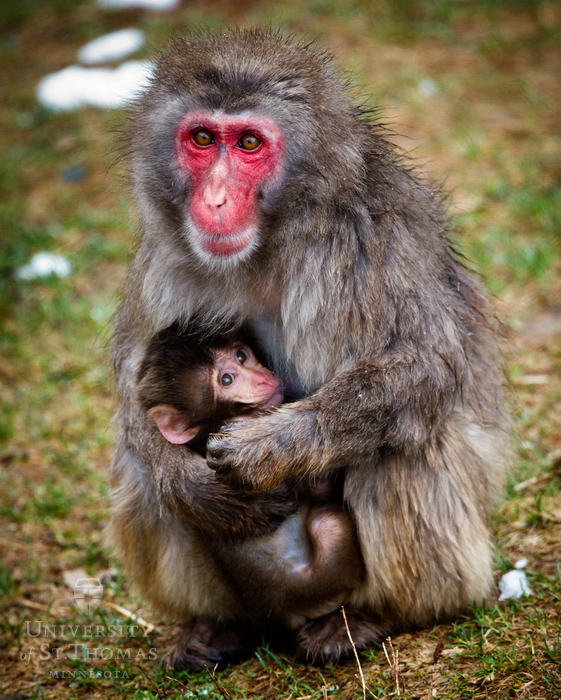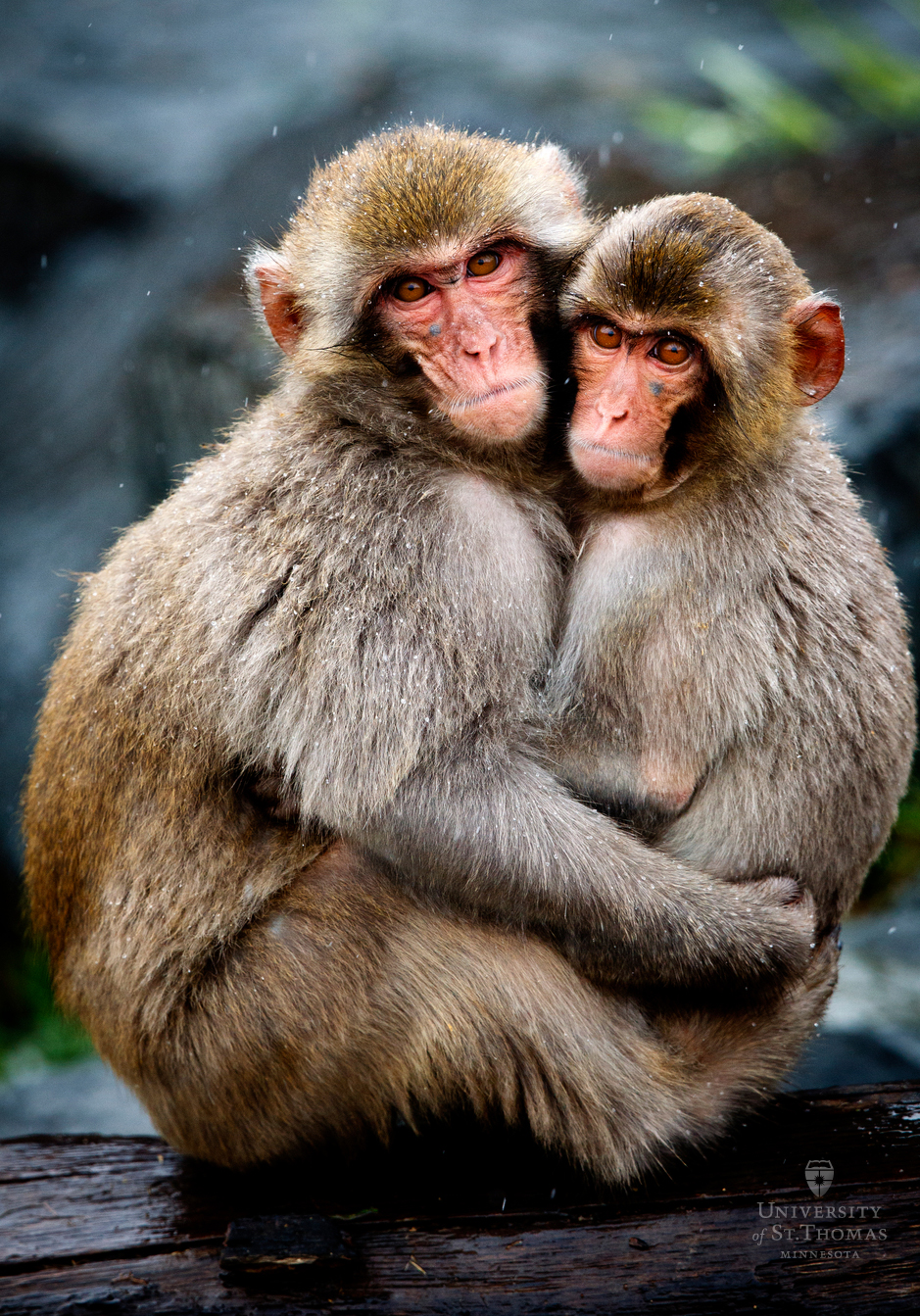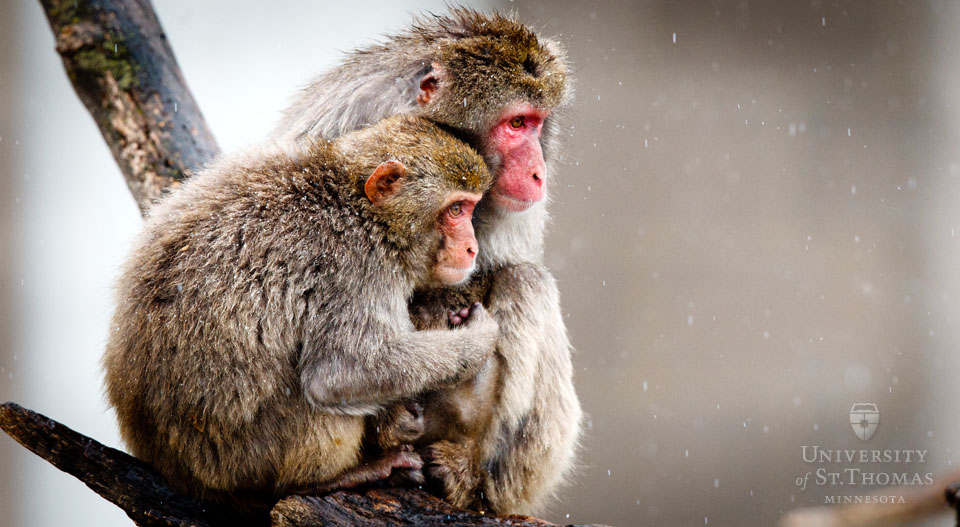On a blustery, 35-degree afternoon in late April, the outdoor snow monkey exhibit at the Minnesota Zoo is soundless and serene, save for the soft plinks of billions of icy snowflakes hitting the earth like as many glass beads. In the intermittent gusts of sleet and snow, two mama monkeys hug their infants so close the little ones disappear in their downy fur, and a handful of monkeys have partnered up, bracing themselves against the elements in a cozy embrace. The rest sit quietly by themselves – on the large fallen tree trunk atop the lone grassy knoll or beneath the cement overhang along the exhibit's periphery – seemingly oblivious to the unseasonable temperature.

Chelsea Mills (left) and Alex Mathison observe snow monkeys at the Minnesota Zoo as part of their psychology project.
It’s a droll contrast to the indoor viewing area, where a thunderous procession of schoolchildren, hopped up in a frenzy of field-trip fever, press their noses to the windows, beseeching the primates to entertain them.
These Japanese macaques, more commonly known as snow monkeys, are the subject of a study conducted by St. Thomas seniors Paige Peterson, Chelsea Mills and Alex Mathison. The trio recorded six hours of video footage of the monkeys over six days in an effort to study the primates’ play behavior. Specifically, they scrutinized the younger monkeys (under 4 years old) and infants to determine how parental interference influences their play behavior.
One logistical challenge the group faced was dodging the aforementioned packs of children – free from watchful parents' eyes – gone wild. Apparently, they enjoyed monkeying around with their cameras. “There were so many times when our cameras were blocked by a kid standing in front of them − sometimes done on purpose to wave at the camera − or were bumped into, which moved the camera angle around,” Mills said.
When mommy's away, the children will play
Dr. Sarah Hankerson, a psychology professor at St. Thomas and adviser for the project, said, “This project represents one of the first attempts to understand why Japanese macaque mothers are so protective of their young. By focusing on the circumstances surrounding intervention, we can generate strong hypotheses on maternal concern. We can also examine the frequency, composition and timing of play bouts.”
Before beginning the study, Peterson, the project’s lead researcher and a psychology major, hypothesized that "there will be very few events of play (chasing, light biting and pulling, etc.) behavior inside a 10-foot circle of the mothers."
Why? The group expected that the juvenile monkeys, much like humans, would feel less pressure to conform to adult social practices the further away they are from their mothers. They chose 10 feet because it seemed to be the easiest distance when making assessments from afar through videos.

Peterson explained that the social structure of Japanese snow monkeys is considered "despotic" (with the alpha male, beta male and older mothers, in that hierarchical order, ruling the roost) and that, contrary to the popular belief that monkeys swing care-free from tree to tree all day, snow monkeys have low levels of social tolerance.
"Based on previous studies," she said, "it appears that since mothers don’t have good social bonds with other adults, they are going to be more protective with their offspring. This prevents the young monkeys from having contact with other group members. Babies are overprotected and grow into overprotective parents. It’s a cycle. They’ll try to play, but mothers usually keep one hand on their babies.”
Hankerson explained further that “as a result of strong maternal concern, it is possible that Japanese macaque juveniles need to be 'sneaky' in order to engage in play behavior." She added that of any well-studied primate species, snow monkeys are the top party poopers – a fact that sparked Peterson's curiosity; likewise, much of primate research investigates the connections between humans and or evolutionary predecessors, and according to past research the team scoured before beginning their study, scientists already have determined that both humans and primates spend much less time playing as they become grown-ups.
According to Hankerson, "Non-human primates can tell us a lot about the basic structure of behavior in group settings. We can look at the rudimentary way individuals handle conflict and affiliation. Being highly social animals, Japanese macaques can serve as models of group dynamics. This study looks at play behavior, which may seem a non-functional activity, but infants (both human and non-human) develop skills, improve physical strength and dexterity, and learn a lot about the world around them and their place in it by engaging in play behavior."
The students' research of human children found that the tapering of children's play behavior coincides with the time period when schools eliminate recess from the children's school day – roughly at the end of middle school.
Furthermore, Mills and Mathison explained, "In humans, authority figures place pressure on children to stop playing, causing play to become less frequent as they grow older. This pressure may be perceived by children that it's time to focus on school and conform to a more structured schedule. Seeing this sort of behavioral pattern in snow macaques could suggest that we are not the only species to experience these types of pressures."
What the group found after reviewing the footage was consistent with their hypothesis, with a small twist. Mills said, "The young monkeys played more often, and for longer periods of time, when they were farther away from the mothers. Chasing play tended to happen even if their mothers were close (less than 10 feet away), but a lot of the wrestling and biting play happened when they were farther away (more than 10 feet ). When the mothers were close and the young monkeys started wrestling, the mothers tended to interrupt their play, too."

She added that while play behavior lets young monkeys practice certain behaviors on their own (such as how to avoid a predator), it can be troublesome to the group as a whole. "Play behavior tends to draw a lot of attention to the group, making them more noticeable to predators," Mills noted. "Along these lines we can kind of understand the role it plays in human behavior, too. While playing for a child is really important in their own individual development, it's only when they reach the age when play stops that they can really start contributing to society as a whole. I think whether that is a good thing or bad thing just depends on how you look at it and what you consider to be more important."
Although there are many mysteries still to be solved regarding snow monkey behavior, relatively speaking, much has been discovered, as they are among the world's most studied animals.
The group hopes that "this research could help give insight into the complicated evolutionary pressures we experience today and the reasons behind why we experience them."

About snow monkeys
Japanese macaques are the northernmost-living nonhuman primate and are native to Japan. Many inhabit northern Nagano, a mountain town in Japan that hosted the 1998 winter Olympics.
They are one of the few animals that are known, like humans, to wash their food before eating it. Their diet includes insects, soil, leaves, fruit and fish.
They also have been known to roll snowballs and fling them at each other in playful fights.
So why weren't the monkeys, uh, monkeying around much on that cold day in April? Peterson shrugged and took a guess: "I think they're a lot like us that way. In this weather they just want to hole up and keep warm."







